Leonard Brillson
Editor, INTERSECTIONS
Member, Government Affairs Committee
Welcome to our INTERSECTIONS Newsletter!
Since our last newsletter, events nationally and in Congress have been tumultuous, directly affecting legislation and funding to support our science and technology community. The MRS Government Affairs Committee (GAC) aims to understand the dynamically changing legislative policy environment and its impact on materials research.
GAC Chair Kevin Whittlesey emphasizes the importance of all of us actively advocating for science. He specifically highlights the new GAC activities that we can participate in.
Our MRS Director of Government Affairs, Damon Dozier, describes the budget agreements now forming, that are meant to address government spending overall and raising the debt limit, but which will strongly affect budgets of all our science and technology institutions.
Brent Carey, our Grassroots Subcommittee Chair, calls to our attention the importance of sending Materials Voice letters to Congress from our upcoming MRS Meeting in Boston.
In the Fellowship Corner, Gavi Begtrup, announces the arrival of this year’s MRS/OSA and MRS/TMS Congressional Science and Engineering Fellows on Capitol Hill, as well as describing our current Fellows’ activities in their Senate offices this year.
Government Agency Subcommittee Chair, Dio Placencia, describes further refinement of the Government Agency talks at the 2017 MRS Fall Meeting to maximize productive interactions between attendees and agency leaders.
Finally, George Malliaris’s INTERSECTIONS article on value-added materials science features yet another success story, highlighting how investments in materials science pay off in ways that the general public and especially our elected officials can relate to.
MRS is working hard to make sure that the materials research community is being heard and that it has input in developing effective government policy for support of materials science. Here is the latest news.
Government Affairs Committee Chair News—The Importance of Science Advocacy
 Kevin Whittlesey
Kevin Whittlesey
Chair, Government Affairs Committee
As the political environment in Washington continues to be highly partisan and amid tremendous uncertainty regarding the budget outlook for science programs, advocacy for science is even more important. The Government Affairs Committee (GAC) is rolling out a number of new efforts to improve our outreach to and education of MRS Members regarding policy and advocacy. GAC’s Advocacy Education and Outreach (AEO) Subcommittee is leading several new initiatives on this front.
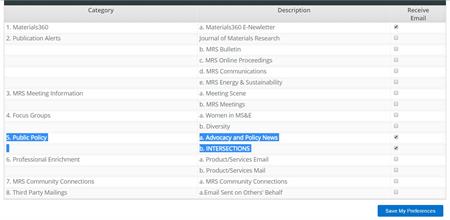 At an advocacy town hall meeting held at the 2017 MRS Spring Meeting earlier this year, GAC heard very clearly from attendees that there was interest in a GAC-specific mailing list to keep members abreast of ongoing activities in the advocacy and policy arena. I am pleased to announce that GAC is launching a new opt-in email list entitled, Materials Advocacy and Policy News. This list will be used to share important policy news affecting the MRS Community, updates about GAC activities, and calls for action when advocacy efforts by MRS Members are needed. To receive information on Public Policy, subscribe at www.mrs.org/my-mrs and check Advocacy and Policy News (see image above). If you do not remember your login, request it here.
At an advocacy town hall meeting held at the 2017 MRS Spring Meeting earlier this year, GAC heard very clearly from attendees that there was interest in a GAC-specific mailing list to keep members abreast of ongoing activities in the advocacy and policy arena. I am pleased to announce that GAC is launching a new opt-in email list entitled, Materials Advocacy and Policy News. This list will be used to share important policy news affecting the MRS Community, updates about GAC activities, and calls for action when advocacy efforts by MRS Members are needed. To receive information on Public Policy, subscribe at www.mrs.org/my-mrs and check Advocacy and Policy News (see image above). If you do not remember your login, request it here.
As an additional means of outreach, GAC is developing a series of articles for MRS Bulletin on policy- and advocacy-related topics of interest and relevance to MRS Members. An article about advocacy will appear in the September issue by GAC Member and former MRS/TMS Congressional Science and Engineering Fellow, Jennifer Nekuda-Malik. Later this fall GAC will publish an article summarizing how the federal budget process works and the ways in which MRS advocacy can influence that process. Look for additional pieces in MRS Bulletin from GAC in 2018.
For those attending the 2017 MRS Fall Meeting (F17), GAC will again be sponsoring a number of activities to connect members with our policy and advocacy efforts. GAC activities at F17 include the Materials Voice booth that provides an easy platform for members to directly advocate for research funding and other important policy topics, and presentations about new research funding opportunities by representatives from a number of different government agencies. This issue of INTERSECTIONS includes a list of the GAC activities to look for and participate in at F17. Here they are:
At the 2017 MRS Fall Meeting
Materials Voice Kiosk
Sunday–Thursday, November 26-30
We need your help in support of sustained federal research funding for the National Science Foundation, the Department of Energy, Department of Defense Basic Research, and the National Institute of Standards and Technology in their Fiscal Year 2018 (FY 2018) and beyond budgets. We must ensure that the commitment by Congress to fund science continues.
Congressional Science and Engineering Fellowship Program Information Session
Monday, November 27 | 5:15–6:15 pm
MRS offers exciting opportunities for scientists to learn about the field of science policy by spending one year as a Special Legislative Assistant in the U.S. Congress in Washington DC. In this session, attendees will learn about the MRS/OSA and MRS/TMS Congressional Fellowships and hear from current and former Fellows about their experiences as scientists in the Senate and House of Representatives.
Research Funding Opportunities Sessions
Tuesday and Thursday, November 28 and 30 | 5:30–8:00 pm
For each session, three government agency program managers will give 20-minute presentations on the overall focus of the agency’s materials science research efforts, programmatic descriptions of how to collaborate or apply and other general details. Afterwards, the program managers will meet in individual rooms to present additional information, host a longer Q&A session or allow for one-on-one interaction with MRS Members.
Frontiers of Materials Research—National Academies of Sciences, Engineering and Medicine Town Hall Meeting
Wednesday, November 29 | 3:00–5:00 pm
The National Academies of Sciences, Engineering, and Medicine are seeking community input for a study on the future of materials research (MR). Frontiers of Materials Research: A Decadal Survey will look at defining the frontiers of materials research ranging from traditional materials science and engineering to condensed matter physics. Please join members of the study committee for a town hall to discuss future directions for materials research in the United States in the context of worldwide efforts.
What's Happening in Washington
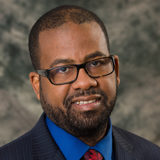 Damon Dozier
Damon Dozier
MRS Director of Government Affairs
After a September recess and a period of activity that saw little progress in passing appropriations bills before the September 30 deadline, Congress has returned to Washington and has begun to work on a number of agreements meant to address government spending and the raising of the debt limit.
If officials cannot negotiate a final or stopgap spending agreement for FY 2018, large portions of the federal government will shut down when the current fiscal year ends on September 30. In recent history, Congress has almost always resorted to passing one or more “continuing resolutions” that temporarily extend funding at current levels, buying time to reach a final agreement. Although many members are loath to permit funding to run out following the politically damaging 16-day shutdown that occurred in 2013, a number of contentious issues, such as whether the final package should include funding for President Trump’s U.S.–Mexico border wall, raised the chance for a deadlock this year.
In addition, toward the end of September the government is expected to reach the statutory limit on the amount it can borrow to finance the national debt. Although many in the Administration and Congress advocate a “clean” raise of the limit, some in the Republican caucus may try to use it as leverage to obtain concessions on spending cuts. A previous impasse over lifting the debt limit led to the Budget Control Act of 2011 that set ten years of hard caps on discretionary spending — the portion of the budget from which the vast majority of R&D programs are funded. Although they have been modified in past years, the caps remain in effect.
In light of all these issues, President Trump recently made an agreement with Congressional Democrats to prevent a government shutdown, raise the debt ceiling and provide emergency financial assistance to areas affected by Hurricane Harvey. Congress was expected to approve a package the week of September 4 that would include $7.85 billion targeted toward Hurricane Harvey and would raise the debt ceiling and fund the government through December 15.
Republicans initially pushed for an 18-month debt-limit extension that would have delayed addressing these issues until after the 2018-midterm elections. The agreement still has to pass through both chambers, and may face resistance from some members who want to back relief for Harvey victims but do not want to vote on legislation that raises the debt ceiling or a funding bill that does nothing to restrict future government spending.
In other funding news, the Senate Appropriations Committee was scheduled to release its spending bill that funds the National Institutes of Health and the Education Department the week of September 4. The Senate version of the National Defense Authorization Act, which sets policy for the Defense Department and the National Nuclear Security Administration, will be considered for a floor vote shortly thereafter.
On the other side of the Capitol, the House is planning to vote soon on the eight spending bills it did not already pass in a security-focused appropriations package in July.
The National Academies decadal survey committee for materials research recently held its third meeting in Chicago. The project is co-sponsored by the Department of Energy and National Science Foundation, and the decadal survey is an important mechanism for identifying the materials science community’s top research priorities for the next ten years. At the 2017 MRS Spring Meeting held in Phoenix, the NAS held an open “town hall” meeting for MRS Members interested in commenting on the study, and another similar type of event will be held at the 2017 MRS Fall Meeting in Boston.
Grassroots Subcommittee Chair News—MRS Grassroots Advocacy
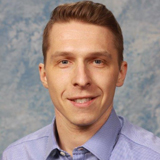 Brent Carey
Brent Carey
Chair, Grassroots Subcommittee
Just a quick note as we gear up for the 2017 MRS Fall Meeting. Perhaps the chill many of us in northern climates are starting to feel in the air is symbolic of the collaboration – or lack thereof – inside the D.C. beltway as we enter the homestretch of 2017. There’s been some contentious horse-trading in the halls of Congress around the budget process, national disaster relief, and myriad other issues over the past weeks and months. Suffice it to say, there has been much to focus on that is not R&D or materials related.
However, it’s looking as if another “budget band-aid” (i.e. continuing resolution) will be passed to avert a government shutdown until mid-December or so. That would happen to be convenient timing for Materials Voice letters to be sent from the MRS Fall Meeting and have maximal impact on such pivotal legislation. The Grassroots Subcommittee is working now to identify critical issues to highlight in our batch of pre-drafted letters. So if you’ll be attending the meeting in Boston, please be sure to drop by the Materials Voice kiosk to send these letters to your elected representatives!
MRS Congressional Science & Engineering Fellowship Corner
 Gavi Begtrup
Gavi Begtrup
Chair, Congressional Fellow Subcommittee
The 2017-18 Congressional Fellows have arrived in Washington!
At the beginning of September, our new Congressional Science and Engineering Fellows, Sarah Vorpahl [MRS/Optical Society of America (OSA)] and Scott Litzelman [MRS/The Minerals, Metals and Materials Society (TMS)], joined former MRS Fellows for our annual kickoff breakfast at Café DuPont in DuPont Circle. This was a chance for Sarah and Scott to be introduced to our wonderful Fellows’ alumni network, as well as to hear anecdotes from years on the Hill, ranging from Congressional antics to stories of how national events and disasters changed the scope of fellowship years.
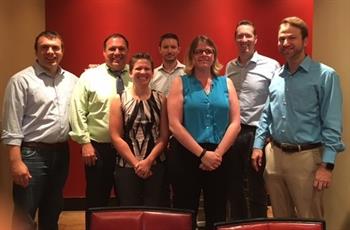 |
From left: Ed Herderick, Eric Werwa, Laura Povlich, Drew Steigerwald, Sarah Vorpahl, Scott Litzelman, and Gavi Begtrup
Felicia and Aaron are now wrapping up a two-week-long science policy orientation program organized by the American Association for the Advancement of Science (AAAS) to provide an introduction to the policy and political landscape before they begin interviewing with Congressional offices to find their placement for the duration of their fellowship year. Look for an update in a future issue of INTERSECTIONS for information on their placement offices and policy issue areas.
The new Fellows are the 31st and 32nd that MRS has sponsored, and represent the 23rd year of the Fellowship. The growing fellowship alumni network boasts leaders in positions across the spectrum including academia, industry, startups, government and policy, as well as a number who have remained on the Hill in various capacities.
Our 2016-2017 MRS Congressional Fellows, Felicia Lucci (MRS/OSA) and Aaron Dunn (MRS/TMS) have completed their fellowship year, working in the offices of Senator Heidi Heitkamp (D-ND) and Senator Gary Peters (D-MI), respectively. As a fellow in Senator Peters’ office, Aaron handled a portfolio that included topics related to the Senator’s position on the Space, Science, and Competitiveness Subcommittee and the Armed Services and Homeland Security Committees. He worked on a range of issues including space policy, open data, nuclear nonproliferation, bioterrorism, artificial intelligence, genetic engineering, makerspaces, and autonomous vehicles. Highlights of his fellowship include drafting the Preserving Data in Government Act, crafting speeches on the importance of basic science funding and the International Space Station, drafting a foreign policy article on nuclear nonproliferation, and viewing the launch of a commercial resupply mission to the International Space Station. Following his time in Congress, Aaron has returned to the high school classroom as a physics teacher and co-grade level chair at YES Prep Public Schools.
As a fellow for Senator Heidi Heitkamp, Felicia supported the legislative staff on energy & environmental policy focusing on an all-of-the-above energy policy including fossil fuels and renewable energy. Through meeting with constituents and stakeholders in both North Dakota and Washington, DC, Felicia saw first-hand the short- and long-term challenges for North Dakota’s energy sector and the direct impact on communities. She regularly prepared briefing materials, drafted letters to the administration, and researched Presidential nominations and regulatory review through the Congressional Review Act. During the appropriations process, Felicia assisted in conveying the Senator’s priorities including contributing to the Senator’s call for robust funding for research and development of Carbon Capture Utilization and Storage (CCUS) technology. Felicia also co-led the Science Diplomacy Affinity Group in the AAAS S&T Policy Fellows Network, where she coordinated the proposal for a symposium on international water diplomacy. Following the fellowship, Felicia is looking to continue working on energy policy and research.
2017 MRS SPRING MEETING—
Conversations with Government Agency Representatives Regarding Funding in Research
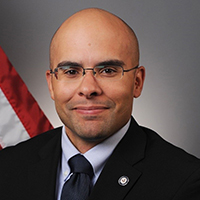
Diogenes (Dio) Placencia
Chair, Government Agency Subcommittee
As we fast approach the 2017 MRS Fall Meeting, there are plenty of items we’ve been working on within the Government Agency Subcommittee to further enhance your Membership experience. As you may already know, our Subcommittee seeks to expose our Members to the various funding agencies within the U.S. Government, private foundations, and international entities. Previous years have seen participation from organizations like the Keck Foundation, the Department of Energy, NATO, among many others. This year, we seek to bring a great lineup of funding organizations that will represent the diverse nature of materials research within our organization.
In addition to our continual effort to diversify our Funding Opportunities lineup, we constantly seek to optimize Member-Program Manager (PM) interactions. As you may already know, the format of our session gives PMs ~15-20 minutes to present their agency’s/organization’s funding interests (first segment), followed by round-table discussions between PMs and Members (second segment). You may also recall that at the 2017 MRS Spring Meeting, our format was well underway, and received tremendous support from participating Members. This Fall, we seek to improve upon that model by:
- maintaining presentations from PMs succinct, so as to optimize your time at the conference;
- allowing for a few questions during our first segment, so as to rectify common questions that might have developed within participating Members;
- allowing for even more time for Member-PM interactions without having to sign up for those crucial-one-on-one interactions.
Further, PMs will be given the discretion to navigate Member interactions to a higher degree. So, for example, the National Science Foundation (NSF) might decide to present additional information on some exciting opportunities currently being developed within the agency within one meeting room, while the Army Research Office (ARO) might decide on the more one-on-one approach to interacting with Members in another meeting room. Members will be able to float between the rooms for ~1.5 hours to allow them the freedom to interact without restrictions. Regardless of the choices being presented, we will be looking for feedback (as always) to continually enhance the experience to the people that matter the most…you!
As we move forward into the Fall, keep in mind that MRS’ operating committees are here to serve you. Our Subcommittee is dedicated to helping our Members achieve their funding goals across the multitude of organizations both nationally and internationally. With each passing meeting, we will continue to facilitate these interactions and hope that our efforts are useful in your quest to push the bounds of Materials Research above and beyond their limits!
See you in Boston!
A Value-Added Materials Research Story—Wiring Brain and Electronics with Conducting Polymers
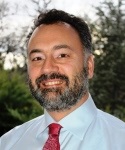
George G. Malliaras
Professor, Prince Philip Professor of Technology,
University of Cambridge
About 18 years ago I was preparing to teach an electronic materials course at Cornell University when I came across a statement by Tadahiro Sekimoto, former President of Nippon Electric Corporation (NEC): “those who dominate materials, dominate technology.” This aphorism, pronounced originally for the electronic materials industry, seems to also apply to my current area of research which is bioelectronics.
I think of bioelectronics as the interfacing of nature’s crowning achievement (humans), with humankind’s most advanced engineering venture (microelectronics). This is an interdisciplinary endeavor that has many facets, ranging from exploring fundamental scientific questions, to engineering new tools for treating disease and disability. Starting with the work of Galvani in the 18th century, experiments with electricity and tissues have shed light into the workings of the brain, led to the development of implantable electronic devices such as the cardiac pacemaker and the cochlear implant, and inspired new “neuromorphic” concepts in information processing. Today, brain implants that control prosthetic limbs are being developed for people with limited mobility, and deep-brain stimulation is increasingly being used as a treatment for the symptoms of Parkinson’s disease. At the same time, the pharmaceutical industry is beginning to explore “bioelectronic medicines”, aiming to replace some pills or injections with electrical stimulation from implantable devices. Further into the future, electronic tattoos will monitor our health on a continuous basis, providing a wealth of data that will revolutionize medicine and help personalize disease treatment.
Organic electrochemical transistor array placed on the cortex of a rat. These devices record brain activity with dramatically improved signal-to-noise ratio compared to electrodes and allow to record signals that originate from deeper in the brain.
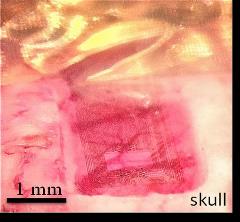 |
Key to these technologies is the high-quality interface between tissue and electronics. Major differences exist in terms of mechanical (low vs. high Young’s modulus) and electrical (ionic vs. electronic conduction) properties at the two sides of this interface, limiting implant performance and lifetime. I belong to a community that explores the use of organic electronic materials as a means to bridge these differences and improve implant performance. In 2011, we reported highly conformable conducting polymer microelectrodes for recording brain activity. The compatibility of the polymer with flexible substrates enabled an improved mechanical contact with the cortex, while its ability to conduct both electronic and ionic charges led to a decrease in the electrochemical impedance compared to the state-of-the-art. The net result was a significant improvement in the quality of the recordings. Further advances were achieved through the use of electrochemical transistors, which amplify the recorded signal and yield even higher quality recordings than electrodes. The improvement in the signal-to-noise ratio is such that the same amount of meaningful information can now be gathered 10 times faster. Moreover, these devices can capture signals that originate from deeper in the brain. In parallel with device engineering, we are spending a great deal of effort looking into the fundamentals of the mixed electronic/ionic conductivity in these materials, and this effort has led to the design of new polymers with improved device performance. The path to better neural interfaces goes indeed through the design of new materials.
One of the most satisfying moments of my career was when Dion Khodagholy, a former student of mine and now a faculty member at Columbia University, translated conducting polymer microelectrodes to the clinic. Dion pushed the spatial resolution of these devices to their limit and showed that they can record the activity of single neurons without penetrating the brain. New teams are joining in this translation effort and these devices are currently being used to study the human cortex with unprecedented spatial resolution.
The next step in the journey will be the commercialization of organic bioelectronic devices. The implantable electronic medical device industry has historically been rather reticent to adopt new materials innovations, mostly due to the enormous risk associated with implant failure. The cost of neurological disease, however, has been estimated to 800 billion dollars a year in the US alone, and new materials solutions are needed to improve implant performance and expand their scope. Obama’s Brain Initiative as well as recent high-profile ventures in the area of bioelectronics announced by Google/GlaxoSmithKline, Chan-Zuckerberg (Facebook) and Elon Musk (Tesla) rely on such new materials solutions. Sekimoto’s aphorism is becoming a reality in the area of bioelectronics.
Feedback
We welcome your feedback and invite you to submit topics for consideration in future issues of this newsletter. If you have or know of stories that illustrate how an investment in materials research paid off in real dollar terms, please send your suggestions to INTERSECTIONS Editor, Len Brillson, at [email protected]. Please send your comments to [email protected].
Sign up for MRS newsletters and alerts by visiting My MRS. There you can login or create an account, and select INTERSECTIONS under Public Policy to receive this quarterly newsletter via email.
Not a current MRS member? It’s never too late to join or renew.